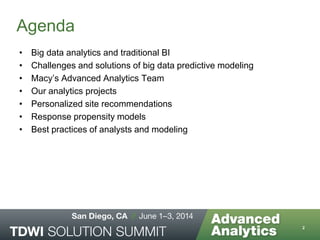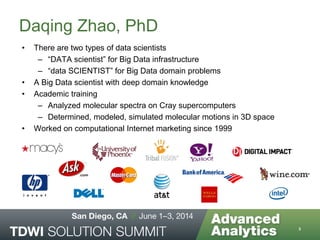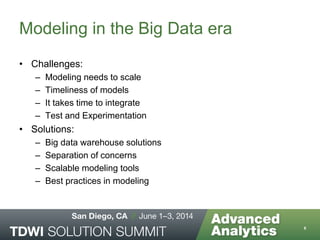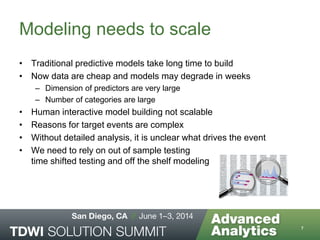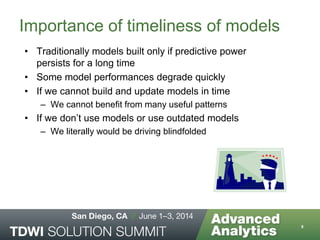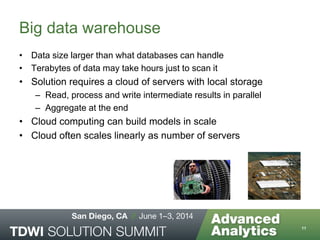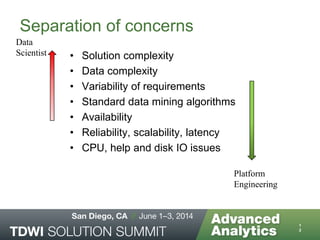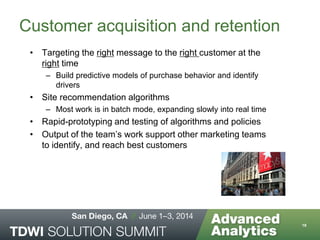TDWI Solution Summit San Diego 2014 Advanced Analytics at Macys.com
- 1. Advanced Analytics at Macys.com Daqing Zhao, PhD Director of Advanced Analytics, Macys.com June 2, 2014
- 2. Agenda • Big data analytics and traditional BI • Challenges and solutions of big data predictive modeling • Macy’s Advanced Analytics Team • Our analytics projects • Personalized site recommendations • Response propensity models • Best practices of analysts and modeling 2
- 3. Daqing Zhao, PhD • There are two types of data scientists – “DATA scientist” for Big Data infrastructure – “data SCIENTIST” for Big Data domain problems • A Big Data scientist with deep domain knowledge • Academic training – Analyzed molecular spectra on Cray supercomputers – Determined, modeled, simulated molecular motions in 3D space • Worked on computational Internet marketing since 1999 3
- 4. Big data, Big Opportunities • Thanks to Moore’s law, on CPU, storage, network connections • Too much data, too little knowledge • Data, analytics changed every field many times over • From science, government, to commerce 4
- 5. Traditional BI process • Data can be accessed and analyzed only after ETL • Schema definition may not be optimal 5 Knowledge Discovery Segmentation and Predictive Modeling Multidimensional Report Standard Report Schema definition, ETL into RDBMS Most companies Stay in this area Baseline Consulting
- 6. Modeling in the Big Data era • Challenges: – Modeling needs to scale – Timeliness of models – It takes time to integrate – Test and Experimentation • Solutions: – Big data warehouse solutions – Separation of concerns – Scalable modeling tools – Best practices in modeling 6
- 7. • Traditional predictive models take long time to build • Now data are cheap and models may degrade in weeks – Dimension of predictors are very large – Number of categories are large • Human interactive model building not scalable • Reasons for target events are complex • Without detailed analysis, it is unclear what drives the event • We need to rely on out of sample testing time shifted testing and off the shelf modeling Modeling needs to scale 7
- 8. Importance of timeliness of models • Traditionally models built only if predictive power persists for a long time • Some model performances degrade quickly • If we cannot build and update models in time – We cannot benefit from many useful patterns • If we don’t use models or use outdated models – We literally would be driving blindfolded 8
- 9. It takes time to integrate • Make sure the data are in place • Measurement and attribution • Start conversations about model based decisions • Teams need to think in model metrics • Organization needs to adapt • Accumulate assets of creatives, best practices 9 1 2 3 4 5
- 10. Test and Experimentation • Testing and experimentation is key to success • Customer response behavior is complex • New different versions, new models, new messages • Do split traffic tests for web or email • Find the winners, and gain learning • Often there are test design problems and understanding their implications 10
- 11. Big data warehouse • Data size larger than what databases can handle • Terabytes of data may take hours just to scan it • Solution requires a cloud of servers with local storage – Read, process and write intermediate results in parallel – Aggregate at the end • Cloud computing can build models in scale • Cloud often scales linearly as number of servers 11
- 12. Separation of concerns • Solution complexity • Data complexity • Variability of requirements • Standard data mining algorithms • Availability • Reliability, scalability, latency • CPU, help and disk IO issues 1 2 Platform Engineering Data Scientist
- 13. Scalable modeling tools • Out of sample testing, cross validation • Fast and scalable modeling algorithms • Model comparisons and selections, model management tools • Automated model optimization tools • Penalize models being unnecessarily too large • Ensemble models • Robust models, handling missing variables, and outliers • Convenient model building environment • Graphical tools • Model deployment tools 13
- 14. Best practice big data modeling • Understand how the data are collected, what data can and cannot be collected • Balance cost of collecting data and optimize modeling • Model performance depends on quality of data • Use automated, robust model building solutions • Use feedback loop to test hypotheses • Do simulations to see if changes are reasonable • Good ideas are not necessarily complicated • Focus on domain knowledge, not just data mining tools 14
- 15. Macy.com’s Advanced Analytics • We are at the frontiers of Big Data science • We have predictive modeling, experimental design and data science teams • Our team members have very strong background in – Quantitative fields, math, stat, physics, bioinformatics, decision sciences, and computer science – We collaborate with systems and IT teams internally as well as 3rd party vendors like WibiData, SAS Research, IBM Research… • We use a wide range of tools Hadoop, SAS, SAP/KXEN, R, Mahout, and others • We are data scientists with keen focus on domain problems 15
- 16. Customer acquisition and retention • Targeting the right message to the right customer at the right time – Build predictive models of purchase behavior and identify drivers • Site recommendation algorithms – Most work is in batch mode, expanding slowly into real time • Rapid-prototyping and testing of algorithms and policies • Output of the team’s work support other marketing teams to identify, and reach best customers 16
- 17. Some other projects • Data organization or data munging – Data collections, individual and event level, 360 degrees, … – Segmentation of customers – Customer value – Multiple channel attribution • Experimentation platform – Both for site layout as well as contents and recommendations • Forecast and optimization – Prediction, simulation, and search and optimize • Big data refinement and scalability – Find new data sources, more efficient ways of accessing data, and organizing and processing data 17
- 20. Customer segmentation 20 Demographic Socio-economic Behavioral Values and styles Channels Modality
- 21. Product social network 21 Demographic Style Size Brand Price range Season
- 22. Who gets which email? 22
- 23. Propensity Models 23 We are building an expanding family of models, at Category/Brand/Outfit… If customer, by category, bought Online/Store, browsed, A2B, Email open/clicks, gender, age, store proximity, Personicx, recency/frequency/spent… Predict buy Men’s Clothes ? Next 4 weeks Up to two years observation
- 24. Data most important • In finding insights and modeling, find key data most important – Identify the smoking gun – Data definition and quality • Data transformations – PageRank is a game changing data transformation – Social graph is a key data transformation for credit card fraud detection 24
- 25. Every wrong data is wrong in its own way • Some data are not collected, “too big” or “useless”, as in flood control, purged log data • Some data feeds to warehouse are incomplete • Multiple definitions and inconsistent business rules, no documentation • Data incomplete due to business nature • Some flaws are easy to catch, such as missing, constant • Some flaws hard to find, partially missing or incorrect 25
- 26. More analysis leads to better quality 26 Data Collection Exploratory Analysis Predictive Modeling Decision Algorithms Better data quality
- 27. Concluding thoughts • Big data presents big opportunity and big challenges • Data science is not about data, but domain solutions • Modeling in Big Data era is different from traditional practices • Organizations need to adapt to model based decisions • Data are not clean until thoroughly analyzed • Scalable and efficient modeling tools are essential 27

